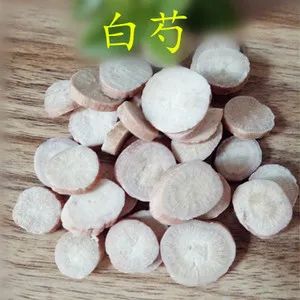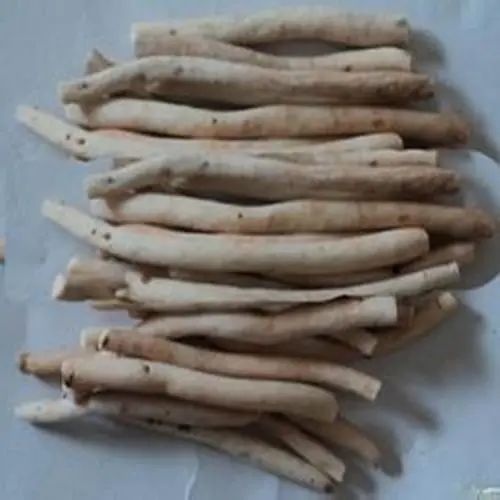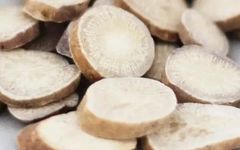Director Ning provides you with knowledge on health and wellnessClick below to follow for free↓↓↓
Bai Shao (白芍) is a natural medicinal herb, derived from the underground roots of the peony plant (Paeonia lactiflora), which are collected, peeled, sliced, and dried. It is known for its ability to invigorate blood circulation, reduce swelling and pain, and expel pathogenic factors while consolidating the body’s defenses. Below is a detailed introduction to the efficacy and functions of Bai Shao, along with its methods of consumption.

The Efficacy and Functions of Bai Shao
1. Pain Relief
Pain relief is the most important function of Bai Shao after it is processed. Bai Shao has significant effects on nourishing blood and softening the liver, which can decrease the body’s sensitivity to pain. It is particularly effective for abdominal pain caused by liver qi stagnation. When treating this condition, it can be combined with other herbs such as Chai Hu (柴胡) for enhanced results, leading to a rapid alleviation of pain symptoms.
2. Prevention of Liver Yang Rising
Bai Shao is a herb that enters the liver meridian, helping to pacify liver yang and prevent its excessive rising. It is particularly effective for symptoms such as headaches, dizziness, and vertigo caused by liver yang rising. It can be consumed as a decoction on its own or combined with other herbs like Sang Ye (桑叶), Ju Hua (菊花), and Bai Ji Li (白吉利) to enhance its therapeutic effects, leading to quicker relief of discomfort.
3. Beauty and Skin Care
Bai Shao has a mild nature and is beneficial for beauty and skin care. It not only nourishes and replenishes blood, alleviating a sallow complexion, but also provides sufficient nutrition to skin cells, promoting their regeneration and reproduction. This can nourish delicate skin and slow down the aging process. For beauty purposes, Bai Shao can be consumed as a tea or ground into a fine powder and mixed with honey to create a facial mask.

Methods of Consumption for Bai Shao
Bai Shao can be consumed in various ways, with the simplest and most common method being decoction. It can be boiled alone or combined with other herbs as directed by a physician to maximize its medicinal effects. Additionally, Bai Shao can be stewed with pigeon meat, which helps to alleviate excessive liver heat and nourish the body, enhancing the immune system.
Bai Shao

This product is the dried root of the peony plant (Paeonia lactiflora), primarily produced in Zhejiang and Anhui provinces. It is harvested in summer and autumn, cleaned, and the heads and fine roots are removed. The roots are boiled in water, peeled, or boiled again before being dried. The best quality roots are those that are thick, long, firm, and free of white hearts or cracks. They are sliced thinly and can be used raw, stir-fried, or prepared with wine.
Identification of the herb: The product is cylindrical, straight or slightly curved, with flat ends. The surface is whitish or light brownish-red, smooth or with longitudinal wrinkles and fine root marks. It is firm, not easily broken, with a flat cross-section that is whitish or slightly brownish-red, with distinct growth rings and radiating rays. It has a faint aroma and a slightly bitter, sour taste. Properties: Bitter, sour, slightly cold. It enters the liver and spleen meridians.
Main Functions: Nourishes blood, regulates menstruation, astringes yin and stops sweating, softens the liver and alleviates pain, pacifies liver yang. It is indicated for blood deficiency, menstrual irregularities, spontaneous sweating, night sweats, flank pain, abdominal pain, limb cramps, liver yang rising, headaches, and dizziness.
Dosage: Decoction, 6-15 grams.
Precautions: Should not be used with Li Lu (藜芦). Not suitable for conditions of yang deficiency and cold.
Modern Pharmacology: The decoction of Bai Shao and paeoniflorin exhibit antibacterial properties, inhibiting pathogens such as Shigella, Streptococcus pneumoniae, Escherichia coli, Salmonella, hemolytic streptococcus, and Pseudomonas aeruginosa. It also increases coronary blood flow, improves myocardial nutrition, dilates blood vessels, counters acute myocardial ischemia, inhibits platelet aggregation, and regulates blood sugar levels. Additionally, paeoniflorin has notable antispasmodic, analgesic, hepatoprotective, and stress-enhancing effects.
Selected Formulas
1. For qi and blood deficiency, and unstable fetal condition: 3 grams each of Ren Shen (人参) and Huang Qi (黄芪), 1.5 grams each of Bai Zhu (白术) and Zhi Gan Cao (炙甘草), 3 grams of Dang Gui (当归), 2.4 grams each of Chuan Xiong (川芎), Bai Shao, and Shu Di Huang (熟地), 3 grams of Xu Duan (续断), a pinch of glutinous rice, and 3 grams of Huang Qin (黄芩), and 1.5 grams of Sha Ren (砂仁). Decoction for consumption.
2. For constipation due to dryness and heat in the stomach: 20 grams of Ma Zi Ren (麻子仁), 9 grams of Bai Shao, 9 grams of Zhi Shi (枳实), 12 grams of Da Huang (大黄), 9 grams of Hou Po (厚朴), and 10 grams of He Huan Ren (否仁). Grind into a fine powder, mix with honey to form pills, taking 9 grams each time, 1-2 times daily with warm water, or can be decocted as a soup.
3. For dysmenorrhea: 60 grams of Bai Shao and 24 grams of Gan Jiang (干姜). Grind into a fine powder, divide into 8 packets, and take one packet daily with yellow wine during menstruation for 3 weeks.
Director Ning provides you with knowledge on health and wellnessClick below to follow for free↓↓↓
Note:Some text and image resources in this article are sourced from the internet. The purpose of reposting this article is to disseminate more information. If there are any errors in source attribution or infringement of your legal rights, please notify us immediately, and we will delete it promptly and apologize.
You might also be interested in:
Chinese Herbs: The Efficacy of Sang Ye (桑叶)
Chinese Herbs: The Efficacy of Wu Huan Zi (无患子)
Chinese Herbs: The Efficacy of Ye Dian Qie (野顛茄)

